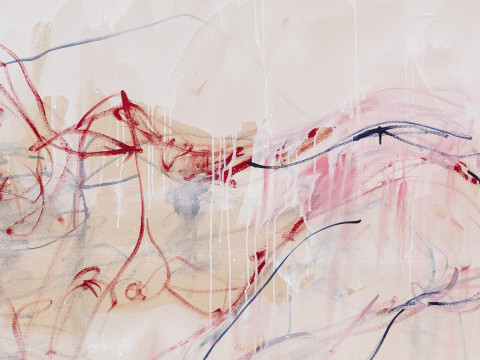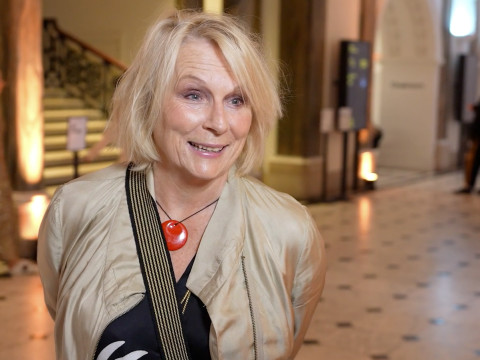
About the Summer Exhibition
Held every year since 1769, the Summer Exhibition displays works in a variety of mediums and genres by emerging and established artists.

Enter your work into the Summer Exhibition
Submissions to the Summer Exhibition 2025 open in January.
The Summer Exhibition is the world’s oldest open submission exhibition – which means that anyone can enter their work to be considered for inclusion. It's happened every year since 1769, and each year a Royal Academician, such as Yinka Shonibare RA, Grayson Perry RA and Jock McFadyen RA, coordinates the exhibition.
In recent years, the exhibition has featured new works by Royal Academicians, Honorary Academicians and artists, including David Hockney RA, Wolfgang Tillmans, Tracey Emin, Bruce Nauman, Wim Wenders and Ed Ruscha.
The works in the Summer Exhibition are selected and hung by Royal Academicians, who also exhibit works in the exhibition, creating an eclectic mix of work by established artists alongside emerging talent and first-time exhibitors. In previous years, nearly two thirds of the exhibits were by non-Academicians, £50,000 worth of prizes was awarded, and over 5,000 works were sold.
Everything you’ll see at the Summer Exhibition represents what is happening in the art world right now. It features new and recent art created by everyone, from emerging artists to the biggest names in contemporary art and architecture. Now more than 250-years-old, the Summer Exhibition continues in the tradition of showcasing a variety of work in all media, including painting, sculpture, photography, printmaking, architecture and film. This must-see exhibition is a unique window onto all areas of the contemporary art world.
Since 2015 all of the works in the Summer Exhibition have been available to browse online with our Summer Exhibition Explorer, with many of the pieces available to purchase.
What is the Summer Exhibition?
At one time the show was known simply as ‘The Exhibition’, where the likes of Gainsborough and Reynolds, Turner and Constable sharpened their skills against each other.
Nowadays, although there’s a plethora of art fairs, commercial galleries and contemporary exhibitions to choose from, the galleries at Burlington House make an unrivalled setting for artists to display and sell their artworks.
For all of the works displayed, the artist is the seller of the work and the Academy takes a 30% commission on all ‘Offers to Purchase’, the proceeds going towards the RA Schools and our diverse programme of exhibitions. The array of works and the celebratory atmosphere of the exhibition make for an unique experience where visitors can browse, buy and discuss the works on show.
In the 18th century all the exhibits were figurative. Hung from dado to cornice, pictures were abutted, tipped towards the viewer and arranged symmetrically. History painting and swagger portraits by the celebrated artists of the day sat on the line (the bottom edge of the exhibit being eight foot from the ground), with smaller pieces below and others by lesser-known artists skied above.
Works came in standard sizes, including the ‘Kit-kat’, and were self-contained in obligatory gold frames. Nowadays the show reflects the gamut of contemporary practices, with works by established and emerging artists often being hung side-by-side. Abstract and conceptual works, which often defy regimentation, are in the ascendant, but traditional techniques and genres are still very much in evidence. In recent years densely hung rooms have been interspersed with lighter spaces and galleries have been dedicated to film works, photography, installations and even to a body of work by an individual artist.
The members of the Summer Exhibition Committee serve in rotation and convene at monthly meetings to discuss the shape of the show, ensuring that each exhibition has a distinctive character. Each Member is responsible for certain areas and the final selection is made during the eight-day hang. The exhibition is finalised on ‘Sanctioning Day’ when the Committee meets for the last time; beyond this point no changes can be made.
Non-Member’s Varnishing Day is traditionally the last opportunity for artists to ‘touch up’ their work. Some still take advantage of this privilege, but on the whole the event is a celebratory one. One of the wonderful eccentricities of the Summer Exhibition is the procession down Piccadilly of artists led by a steel band; another element that distinguishes it from any other show in the world.
The Summer Exhibition in 60 seconds
Never been to the Summer Exhibition before? Find out what all the fuss is about in this short film.
Read more

An archive of 250 years of the Summer Exhibition
In celebration of the Royal Academy's 250th birthday and coinciding with The Great Spectacle exhibition, a new open access publication by the Paul Mellon Centre looks back at 250 years of the Summer Exhibition. Explore 250 years of stories, artworks and data, alongside lively year-by-year essays and a complete set of digitised and searchable Summer Exhibition catalogues.
It's an exhibition selected by artists, hung by artists... we just choose the best art, and try to make sense of it on the walls. It is a truly democratic exhibition.
Norman Ackroyd RA, Summer Exhibition Co-ordinator 2013
Artists' testimonials

"I think my work was successful as it is bold, and confident in both its use of colour and form. I feel that you should always be pushing your practice further, be confident in what you do and don't be afraid to take risks. Mistakes will happen, but they are all part of the development process.
Your work needs to stand out from the 1000s of other entries. Smaller pieces stand a greater chance of inclusion over larger works. Look at the works that have been included in recent years and use them as a yardstick to compare your own to. Be different or be really at what you do; even better, be both. If at first you don't succeed, keep trying until you do."

"Study, research and resolve, I believe are key factors in the quest for success in getting accepted for the RA Summer Exhibition. Although there are of course no guarantees, plus enormous competition, I feel it is helpful to study the art works in the current show, and records of previous shows.
Also reading the RA magazines, and noting what the Royal Academicians say, both in print and on line in their short videos is beneficial. Most importantly, observe carefully and make notes. Absorb the very essence of the RA Summer Exhibition. Breathe it in. Be inspired."

"I try to approach my art with curiosity, and soak up everything around me. I spend time with as many like-minded fellow artists as I can, sharing creative thinking, learning new techniques, and getting inky together. Printmakers should "see one, do one, teach one".
I am also tenacious, entering every year – third time lucky. I looked on rejection as a spur to get better and try more ideas. I submitted different-looking works, as you can't predict the vision of the curators. And it worked. It has made my art better, I think. Thank you RA."



